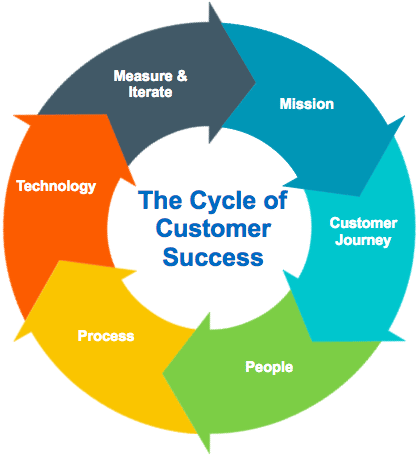How has your company made strides in recent years to help ensure customer success? The customer success strategy involves ensuring clients get the benefits they deserve from your company. Have you looked at things from the point of view of your customers?
How are their interactions with your team? Do they seem to be performing themselves as well as possible? Before we dig into the principles of customer success, let’s first define what customer success is (and isn’t)and why it’s important.
What is Customer Success?
It’s a proactive method of ensuring you’re meeting your customer’s needs to help them succeed with the help of your products and services. The goal is to reduce turnover to keep customers from choosing the competition.
According to HubSpot, “Customer success provides proactive outreach aimed at increasing upsells and cross-sells, positive word-of-mouth, and successful outcomes for customers.”
Customers today have never had more options, and it’s never been easier for businesses to create new products and services. Because of this, there’s more pressure on companies, as sales and marketing aren’t always enough to sustain growth.
Why is Customer Success Important?
Customers are vital to your business, so focusing on their success with your products/services helps with customer retention. When customers are happy and succeeding thanks to your company, they will often refer your business to others.
Hubspot mentions that sales and marketing were the first two growth engines in the business, and customer success is becoming the third growth engine. Customers have more choices than ever; only 3% of people trust industry sales and marketing experts.
Growth will likely stem from customer engagement and how well your company can build a happy customer base and reduce churn rather than how big your sales or marketing teams are.
According to Gainsight, guaranteeing customer success positively impacts businesses, as happy and successful customers are repeat customers (and often bring new customers!).
Customer Success Principles
Some companies have Customer Success Managers who train customers on best practices in the industry and how to employ the product or service best to achieve success. They help determine what is and isn’t working and what else can be done to get results.
Here are the top 5 core principles for customer success:
1. Customers who Adopt more are Likely to Renew
When customers aren’t using your service correctly or as well as they could, they’re not getting the value it offers. This is one of the crucial customer success principles since it emphasizes the importance of helping customers adopt your product or service in a way that maximizes its value to them.
By doing so, customer success teams increase the likelihood that customers who find value in your offering and use it effectively will renew their subscription or continue to use your product. On the contrary, if customers do not adopt the product as intended, they may not realize its full value, leading to a higher likelihood of churn.
Customers who consistently use a SaaS platform have an 80% renewal rate compared to the rate for those with lower adoption rates.
This correlation emphasizes the need for customer success teams to guide users through optimal usage. By offering tailored onboarding, ongoing training, and demonstrating key features, businesses can ensure that customers realize the full potential of their purchase and extract maximum value.
2. Customer Success is not Customer Support
While both contribute to the customer success framework, customer success and support differ in focus. Customer success involves understanding each client’s goals, tailoring strategies, and driving customer value realization. Contrastingly, support addresses specific issues and resolves them swiftly. Also, the customer success framework often is proactive and focused on adoption, while customer support solves issues and is more reactive.
A prime example is Shopify’s customer success approach. They offer personalized assistance to clients, helping them optimize their online stores for success. In contrast, their customer support promptly addresses technical issues. This clear differentiation ensures that new and existing customers receive tailored guidance to flourish in their customer journey while addressing immediate concerns.
In addition, a Gainsight study revealed that companies delivering excellent customer success outperformed others in revenue growth. Therefore, by harmonizing both roles, businesses maximize customer happiness.
3. Customers who Purchase more are More Loyal
Upselling involves offering complementary products or services that align with customer needs. Amazon Prime is a compelling example – Prime members, who purchase a subscription for added benefits like free shipping and exclusive deals, spend around $1,400 per year on average, compared to non-Prime members who spend approximately $600.
Prime members who invest in subscriptions tend to spend more, illustrating a direct correlation between purchasing behavior and loyalty.
Upselling helps improve customer happiness by allowing deeper relationships and more value to be delivered to the customer. By understanding customer preferences and upselling relevant offerings, businesses strengthen their bond with customers, foster loyalty, and increase overall customer lifetime value.
4. Listen to your Customers
This may go without saying, but support managers often overlook good listening and interpretation skills. This principle highlights the importance of listening to your customers. This involves actively soliciting feedback, addressing concerns, and effectively communicating with customers to meet their needs. By doing so, customer success teams can better understand their needs and preferences and tailor your product or service to meet those needs.
A case in point is Airbnb. By paying attention to customer reviews and feedback, they’ve fine-tuned their platform and addressed pain points. According to Edelman’s Trust Barometer, 81% of customers say that trusting a brand to do what’s right is a factor in their purchase decisions.
Implementing tools to gather feedback, conduct surveys, and analyze customer data and sentiment empowers businesses to identify pain points and areas for improvement. By being responsive and addressing feedback, businesses demonstrate commitment to customer success, positively impacting loyalty and positive word-of-mouth.
5. Be a Proactive Advocate for your Customers
Staying on top of arising issues and always keeping your customer’s best interests in mind will result in loyalty and greater trust for your brand. Proactively advocating for customers involves anticipating and preventing issues.
Businesses establish themselves as trusted partners by staying ahead of potential challenges, providing personalized guidance, and ensuring customer satisfaction. This principle underscores the importance of customer advocacy, fostering loyalty, and reinforcing brand reputation through proactive engagement.
By embracing customer feedback and incorporating it into product development, customer success managers play a pivotal role in fostering trust, loyalty, and satisfaction.
Customer success positively impacts the success plans of businesses since happy and successful customers are often repeat customers.
The Golden Rule
The Golden Rule (“Treat others as you would want to be treated yourself”) can be used as a benchmark to ensure clients remain happy and engaged with your company culture.
Here are a few ways in which companies can apply the Golden Rule:
- Respond promptly to customer inquiries
- Listen to what customers have to say
- Be proactive about potential issues rather than waiting for clients to come to you
- Say thank you so customers know how much your company values them
- Continue to share knowledge with clients to help them grow and succeed
Customers are crucial parts of your overall business, so it’s important to ensure they’re happy and continue to succeed with your help.
The Process for Customer Success
Does your company have a process in place? Startups, for example, may not have a system yet, while larger companies may have systems that need to be tweaked.
The customer success process often varies between industries and companies, but a general process may include the following:
- First impressions: Customers will hear about your company and start to think about how your services could be beneficial.
- Evaluation: A customer will choose whether or not they wish to buy. The process begins when payment is received, or a free trial is secured.
- The next phase is gathering client information, such as, “‘What problem are you solving?” “How can we help?”
- Determine who makes the decisions, as working with them can help provide more money for your company and more success for their business.
- Discover how they’re currently solving problems. Knowing what tools they used previously can help you understand how your products and services can better serve their company and provide success.
- Offer training material, webinars, etc.
- Stay in touch. Don’t forget to check in regularly to ask questions, find out if there are any issues, conduct surveys, etc.
- Renewal: The customer will keep using your service. Keep an ‘open door’ and be accessible if customers need something.
How will you keep customers from switching to a competitor? It may help keep communication open so customers feel connected to your company. Chameleon is one company working on their customer success process and working to get a dedicated team together for this purpose. They suggest adding customers to a Slack channel.
In general, the process involves:
- Knowing the customer: Customer needs and goals vary, so it’s important to determine those upfront and work to ensure they’re accomplished.
- Add value to communication: This may include helpful tips and ideas to enhance customer experience.
- Set expectations: Be upfront with customers about what needs to be done to ensure success. Celebrate when customers achieve certain milestones and goals.
Customer Success Process Flow
Sometimes it helps to set measurable goals, track progress, create content to drive adoption and remember to start and end with your goals.
Continue to analyze how successful customers are because of your work, then refine your goals to encourage better success with target customers.
It can also be beneficial to create a customer health score, which includes the following:
- Business Outcomes: Are the results meeting the expectations of the customer?
- Product Engagement: Are the products/services being used properly? What does the usage indicate?
- Service Utilization: Is the customer using the service to its full capability?
- Customer Satisfaction: How is the client feeling about working with your company?
- Support: Are there any outstanding issues?
Thinking through these items and ranking the results could help indicate where customers stand about one another and possibly identify what could be done to help those who aren’t as successful yet.
Best Practices for Customer Success
According to Crunchbase, customer success may look something like this:

Here are the top customer success best practices:
- Even if you have a customer success team, everyone in the company should play a part in keeping customers happy and preventing churn.
- Consider giving customers a way out of a new contract after 90 days to provide your company time to drive success.
- Guage communication based on the size of the customer, but try to contact every customer at least once a month. More prominent clients should be contacted about once a week or so.
- It’s often considered best practice to have one customer success representative for every 40 clients.
- Continue educating customers. Inform them of ways other customers use your tools, as you may show them something beneficial they hadn’t thought of before.
- It’s more important to perfect the features you have now rather than trying to continue to add new features.
- Focus on selling to the right customers who will benefit your company too.
- Your current clients are your best source of new customers. Don’t forget about up-selling different products and services that could benefit them.
Customer success happens when adoption is driven to help benefit both the customer’s business and the company.
After the first stage of initial onboarding, communication may slow down, but it’s important to prioritize customer success. Keep analyzing the situation to gauge the customer segment and performance and consider upselling when necessary.
How Zight (formerly CloudApp) Helps Drive Customer Success
Companies can help keep customers happy and work to ensure their success by taking advantage of our visual communication tool. While it’s beneficial for closing customer support tickets three times faster, it’s also a good tool for proactive work to make sure they’re meeting their goals and seeing success with your company’s help.

Share training materials and tips with Zight’s video capture features.
Is one of your strategies to provide more customer training tools? Use Zight to share videos and clips rather than explaining step-by-step via email. It’s much easier to process more visual information. Show, don’t tell.
Do you have questions? Are you interested in learning more about Zight? We’re dedicated to making communication simpler through video recordings, screenshots, GIFs, and much more.
Sign up today for a free Zight (formerly CloudApp) account. Use it instantly to share thoughts and ideas and receive customer feedback to help ensure customer success.












